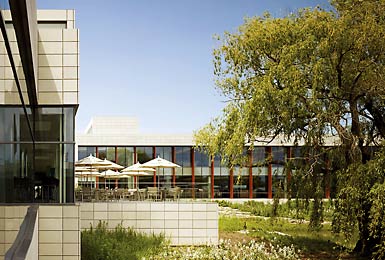Ecodistricts Help Business Achieve Sustainability
Businesses across sectors can achieve greater sustainability by locating in emerging ecodistricts.
March 2011

Adapting some of these measures to the industrial campus is not a significant leap, and certain aspects can be implemented at minimum cost on a gradual basis. Here are a few of many ecodistrict components that could offer value to companies looking to enhance their own communities.
Achieving energy efficiencies: Energy conservation and renewables obviously play a large role in reaching a company's goals of a reduced carbon footprint and lower energy bills.
• Federal, state, and local tax credits can help subsidize building retrofits with improved insulation, weather sealing, efficient lighting, and occupancy sensors.
• More sophisticated energy monitoring systems are now available including sensor-and-response programs that can identify and modify energy use patterns, or HVAC ventilation triggered by air-quality monitors.
• Renewable energy options to meet limited loads include the addition of solar electricity and/or hot water panels on large roofs or adjacent land, as well as waste burning for electricity.
• District-scale thermal systems can minimize distributed use of natural gas for heating and cooling.
Water management is a critical piece of the solution for industry, from fabs to foundries that use enormous amounts of clean water from local watersheds for a variety of uses.
• Water re-use is highly affordable with major cost-saving potential across campuses. Simple solutions such as using greywater for toilet flushing and irrigation of grounds can save thousands of gallons.
• Rainwater capture and storage can reduce potable water usage significantly.
• Stormwater management options include filtering 100 percent of campus stormwater on-site through a district-scale filtering system; use of permeable pavement on top of filtering beds to help eliminate polluted runoff; and vegetative roofs that absorb rainwater.
Creating community and habitat: An important part of ecodistricts is community building and preservation of natural surroundings, both of which foster employee productivity and interaction.
• Volunteer gardens (coupled with flex-time policies that allow for gardening) offer the opportunity to get employees engaged in non-work teams, fostering interchange, productivity, and exercise for those who may not want to go jogging around the campus.
• Invite local vendors in on a periodic basis to offer specialty foods and other products and services. This keeps staff on site (reducing car use and lost productivity) and promoting the company within the local business community.
• Subscription farm produce delivery is increasing in the residential market, but is not often considered by corporate cafeterias. It's a natural fit to supply the salad bars. The benefit is locally grown and healthier food for workers on site.
How do we get there? The name of the game is incremental change, as an investment budget becomes available.
Project Announcements
Castelion Plans Sandoval County, New Mexico, Rocket Motor Manufacturing Operations
11/18/2025
Regeneron Pharmaceuticals Plans Saratoga Springs, New York, Manufacturing Operations
11/17/2025
Southwire Expands Heflin, Alabama, Production Operations
11/17/2025
First Solar Plans Gaffney, South Carolina, Operations
11/15/2025
Ashworth Bros. Upgrades Winchester, Virginia, Production Operations
11/15/2025
Feast & Fettle Plans Elkridge, Maryland, Production-Distribution Operations
11/15/2025
Most Read
-
2025’s Top States for Business: How the Winners Are Outpacing the Rest
Q3 2025
-
Rethinking Local Governments Through Consolidation and Choice
Q3 2025
-
The Compliance Reckoning Is Here
Q3 2025
-
Around the Horn: Data Center Supply Chains — What's Next?
Q3 2025
-
First Person: Filter King’s Expansion Playbook
Q3 2025
-
Rethinking Auto Site Strategy in the Age of Tariffs and Powertrain Shifts
Q3 2025
-
Lead with Facts, Land the Deal
Q3 2025